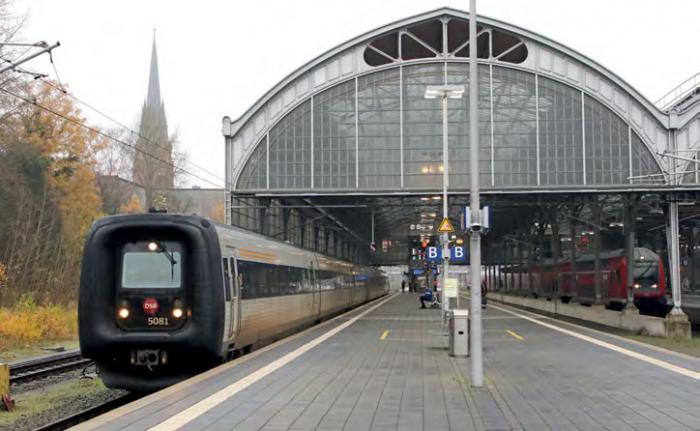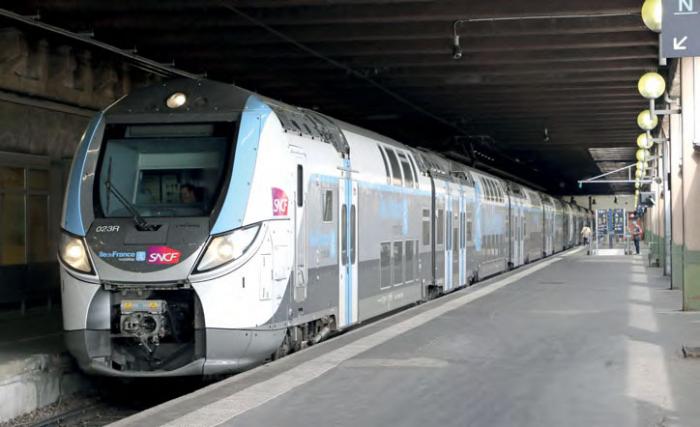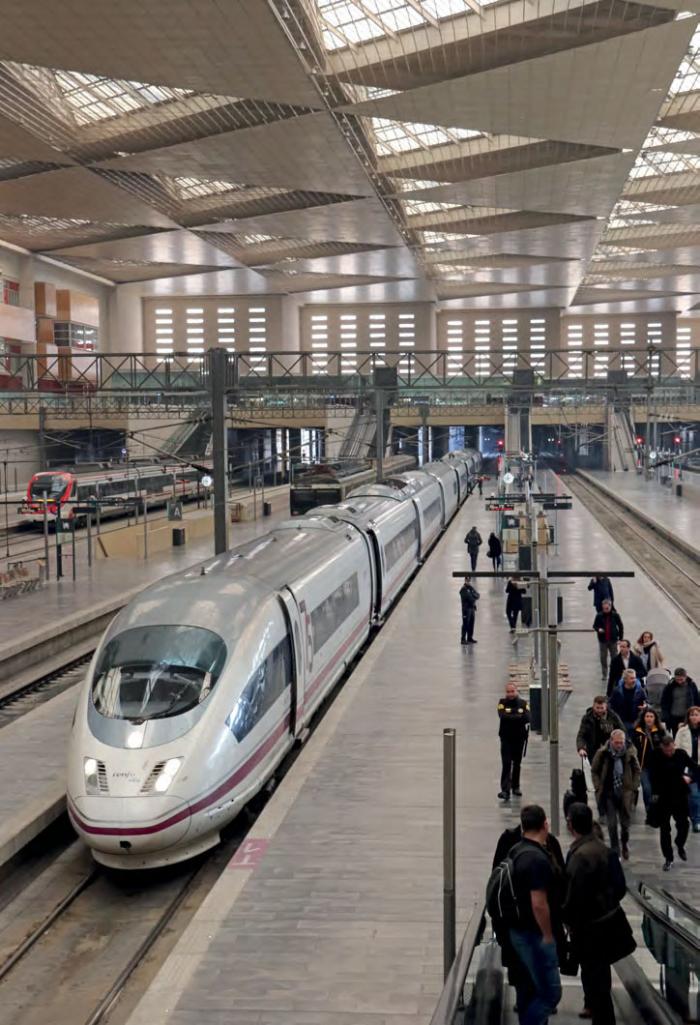EUROPE
BOMBARDIER TO SELL RAIL BUSINESS TO ALSTOM
On 17 February Alstom and Bombardier confirmed they had signed a Memorandum of Understanding for the sale of Bombardier’s Transportation business to Alstom. The acquisition price was expected to be between €5.8 and €6.2 billion and follows a strategic decision from Bombardier to focus on its business aviation segment. The signing of the MoU was unanimously approved by each of Bombardier and Alstom’s board of directors.

The proposed merger comes after a period in which Bombardier has reported worsening financial performance, forecasting losses for 2019 linked to ongoing delays with train fleets in the UK, Germany, Austria and Switzerland which led to additional costs for Q4 2019 alone of $350 million. This led its share price to decline by 37% in mid-January, just before the reports of merger talks became public.
Rail business subsidiary Bombardier Transportation, with a turnover of $8.3 billion, has been 30% owned by Canadian state-owned investment fund Caisse de Depot et Placement du Quebec (CDPQ) since 2016; the transaction is fully supported by CDPQ, which would become a new long-term shareholder of Alstom. Bombardier Transportation’s order backlog at the beginning of 2020 was $35.8 billion (Alstom reported a €43 billion order book for the same period). Full year EBIT (earnings before interest and taxation) profit in 2019 was $22 million – a $752 million reduction compared to 2018.
In mid-February Bombardier sold all its remaining stake in the C-series aircraft business to Airbus (which has rebranded the plane as the Airbus 220) for $591 million; CDPQ retains a 25% interest in the new aviation venture with Airbus. Bombardier retains its business aircraft segment.
Plans for mergers in the European rail supply industry are not new; Alstom and Siemens planned a merger, announced in 2018, which was blocked by the European Commission in February 2019. Bombardier had previously been in talks with Siemens about a merger. It is unclear that any of the factors that led the EU to block the Siemens Alstom merger would not also apply to a potential Alstom Bombardier tie-up; whilst the companies have different strengths and specialisms between them, they constitute a similar sized part of the European market and are particularly strong in France, Belgium, Germany, the UK, Sweden and Italy. Both companies have manufacturing plants in eastern Europe which supply components and car bodies to factories in western Europe. Bombardier has substantial production capacity in China, both for the local market and supplying components to its wider business.

The impact of an Alstom Bombardier merger would be particularly pronounced in France; it remains to be seen what the French Government’s position is, having previously supported the Siemens Alstom merger. Historically, many big contracts in France for both SNCF and Paris metro operator RATP have been effectively shared between Alstom and Bombardier with their two big assembly plants located near Valenciennes in northern France, with one company or the other acting as junior partner.In Italy and the UK Bombardier is working in partnership with Hitachi to develop and build high-speed trains, while in Germany Siemens relies on Bombardier to build most vehicle car bodies for the ICE4 high-speed train.
SABINE CAUSES WIDESPREAD RAIL CHAOS
Storm Ciara, which brought storm force winds of up to 155km/h to the UK on 9 and 10 February, continued past the British Isles to north western Europe, where German forecasters named it Sabine and winds reached hurricane force (170km/h). In Germany some rail services on lines near the North Sea coast between Norddeich and Bremen were suspended from Saturday 8 February in advance of the storm.
Most German operators suspended services, effectively closing the national rail network from early evening on 9 February, although city U-Bahn and tram systems were largely unaffected. Infrastructure manager DB Netze had imposed lower night-time speed limits on top of speed restrictions imposed earlier on those lines that remained open. Services did not begin to return to normal until the afternoon of 10 February in western and southern Germany, with DB Fernverkehr (long-distance) still advising passengers to avoid travelling before 12 February if possible as disruption continued, and the operator was accepting tickets from previous days if passengers had heeded the advice not to travel. By contrast, in some parts of eastern Germany there was little or no weather-related damage, but rail services were still suspended on 9 February, leading to complaints from passenger groups!
International links were affected across a wide area; the Øresund bridge connecting Denmark and Sweden was closed due to the weather from early afternoon on 9 February, shutting the international road and rail fixed link between the two countries. Rail services between Denmark and Germany were also disrupted. As a result of the weather and disruption most overnight sleeper trains operated by ÖBB in both Austria and Germany were cancelled; two trains were provided as static hotel trains in Vienna and Salzburg for passengers who would otherwise be stranded.
Thanks to accurate weather forecasting few accidents and injuries were caused by the severe weather; in Switzerland a Thurbo operated GTW EMU collided with fallen trees at Wald on the Rapperswil to Winterthur line in the east of the country early on 10 February, damaging train and track but not injuring anyone on-board. Several Swiss lines suffered temporary closures, some for several days, due to blockage by fallen trees or overhead line damage.
In the Netherlands one train hit a fallen tree with no injuries and, as is usual in severe winds, the HSL Zuid high-speed line was closed south of Rotterdam as it uses the high and exposed Moerdijk bridge. Remarkably, Dutch infrastructure manager ProRail’s figures indicate that at the worst point of the storm on 9 February around 66% of all trains still ran, and on time!
Disruption was not limited to rail transport; most European airports had large numbers of cancelled flights and ferry services were disrupted or suspended across much of northern Europe.
Our thanks to reader John Morris for some of the information in this item.
DENMARK
TALGO TO BUILD NEW INTERNATIONAL TRAINS
Danish Railways (DSB) has ordered 8x13-coach, 440-seat, 200km/h loco-hauled train sets from Talgo to operate international services to Germany, primarily on the Hamburg to Copenhagen route in preparation for the opening of the new Fehrmanbelt undersea tunnel in 2028. The new trains for DSB will be very similar to the Talgo 230 train sets (ECx) ordered by German operator Deutsche Bahn last year. Talgo beat an alternative offer from Siemens for the DSB contract; several other manufacturers had previously withdrawn from the tender. The contract is worth around DKK1 billion (£111 million) and forms part of a bigger framework contract allowing purchase of further vehicles or complete train sets. DSB will maintain the new trains using parts supplied by Talgo.
The trains, which will be delivered from June 2023 onwards, will operate in top-and-tail mode using the Vectron AC locomotives already on order for DSB from Siemens; 34 locos designated DSB Class EB will be delivered from late 2020 onwards. The new Talgo trains will replace shorter IC3 DMUs currently used to operate international services from Denmark to Hamburg; these will be cascaded to regional services to allow withdrawal of newer (but problematic) IC4 trains supplied by Ansaldo Breda.

Copenhagen to Hamburg trains were rerouted from December 2019 and no longer serve Lübeck in Germany using the Rødby to Puttgarden train ferry route, now using the Storebælt route via Odense and Flensburg due to construction work for the new Fehrmanbelt undersea tunnel. Access lines on both sides are being rebuilt to double track and electrified over the next eight years; in Germany the 88km line between Lübeck and the new tunnel will be either rebuilt (30km) or constructed on completely new alignments (55km), and in Denmark the 115km line between Ringsted and the tunnel will be electrified and rebuilt for 200km/h operation. Copenhagen to Hamburg journey times using the new link and rebuilt routes will take 2hr 30min compared to around 4hr 50min in 2019; the Fehmarnbelt crossing itself is likely to take seven minutes, compared to an hour by ferry (including embarkation etc).

In February Atkins announced it had been awarded a contract by the Danish planning company Femern A/S to provide consultancy services for the railway that will run through the new Fehmarnbelt tunnel.
FRANCE
STRIKES DAMAGE FREIGHT BUT ACCELERATE RER TENDERING
The longest national rail strike in French history ended (for now) in mid-January, having begun around 5 December. The strike was in opposition to government attempts to reform the country’s pension system and was part of nationwide strikes by multiple industry sectors (many currently with sectoral pensions that are better than the average). The pension reforms have yet to be finalised, and parliamentary debate was scheduled for mid-February.
Whilst the strike paralysed the entire national network at its peak, this was due to key personnel such as signalling staff not working rather than all railway employees striking. Private freight operators found themselves unable to run trains even though their employees were not on strike. National operator SNCF was also unable to run many trains on some days, although the situation varied around the country and over time more services were operated.
By mid-January SNCF told the media the strike had cost the company around €850 million; by the end of that month the cost was probably closer to €1 billion. SNCF’s new Chief Executive Jean-Pierre Farandou told local media the company would be looking at asset disposals as one possible means of generating cash – logistics business Geodis being seen by observers as an obvious (and large/valuable) asset that could be sold. The French rail freight sector – already a poor relation compared to many western European peers – has undoubtably suffered long-term damage thanks to six weeks of strikes; one of the country’s main ports at Le Havre was offering container shipping companies big incentives to make ship calls there in January and February as an attempt to win back traffic lost to Antwerp or Rotterdam during the strikes (the ports were also on strike for several weeks).
TENDERING FOR THE RER?
One of several unintended consequences from the strike could be the earlier than planned tendering of Paris area suburban services – currently the busiest part of the entire SNCF passenger operation. On the worst strike days almost no trains ran on the rail or metro networks, with the exception of the driverless Line 1/Line 14 metro routes which did operate.
In early February the Île-de-France region announced it was asking the French Government to accelerate plans for tendering all rail services in its region, including those operated on RER Lines A and B by RATP. The Île-de-France region wants all rail services, including Paris Metro and tram services operated by RATP, to be tendered by 2030, citing the enormous disruption during the strikes as one reason, with the first routes to be handed to new competitively appointed operators by December 2025.

Whilst all other French regions can tender their rail services from 2023, the Île-de-France Region is restricted, with tendering for RER services phased from 2025 to 2040, although several suburban routes can be tendered from 2023.
The Region intends to develop the tender process and documentation during 2020 with initial prior information notices for the planned tenders being issued early in 2021. Three groups of suburban services from Paris St Lazare (‘Line J’), Paris Est (‘Line P’) and Paris Gare de Lyon (‘Line R’) have been identified as early candidates for tendering as transport authority Île-de-France Mobilités is not satisfied with current performance levels.
GERMANY
IC2 DELIVERIES SUSPENDED
German Railways’ long-distance subsidiary DB Fernverkehr has stopped accepting ‘IC2’ double deck push-pull trains from Bombardier, with 21 of the final 25 on order still to be delivered. Bombardier has told local media in Germany it is working with DB to resolve the problems and has regretted the inconvenience the trains’ frequent failures have caused travellers.
DB has ordered 69 of these trains in three batches; the first 25 utilise a Class 146.5 ‘Traxx AC2’ 15kV AC loco and have been in service since late 2015. Despite some early teething problems with the Twindexx vehicle suspension (all versions of the IC2 train use the same five-car formation of Bombardier Twindexx double deck coaches with a driving trailer on one end), these trains have performed well in recent years and most operate on the routes between Emden/Cologne and Leipzig/Dresden via Hannover. The Class 146 design is a well-proven loco used widely for regional trains in Germany.
The next two lots of IC2 trains utilise Bombardier’s more modern ‘Traxx AC3’ loco design – delivered to DB as Class 147.5. The first batch of 17 trains was delivered in 2018-19 and entered service largely on the Nuremberg to Karlsruhe via Stuttgart route. Introduction on the Stuttgart – Singen – Zürich route has been delayed due to approval problems in Switzerland (especially concerning the use of European Train Control System), although operation of domestic German IC trains between Stuttgart and Singen began during 2019. These trains have yet to become reliable, with frequent operational problems that appear to be largely software driven.
The next batch of 25 trains, ordered in 2017, was due to be delivered during 2019, although only the first four trains entered service by December 2019. Since introduction these have experienced significant software related failures with trains stopping unexpectedly and drivers reportedly having to spend up to an hour rebooting the on-board systems to operate normally. These problems appear to be exacerbated by frequent changes of direction at terminus stations – which is a feature of the routes they were bought to be used on, with direction changes multiple times each day!
TALENT EMUs GET LATER STILL
Bombardier’s delivery problems are not confined to the IC2 trains. As we reported last month, the fleet of Talent 2 EMUs on order for use by Abellio around Stuttgart is severely delayed. In recent weeks Abellio has told the Baden-Württemberg regional government (which will own the trains via its in-house leasing company) that the 22 delayed trains are now not likely to be in service by June as originally promised and that approval for operation in multiple as three-unit sets has still not been obtained. Delivery by December appears likely – if achieved this will be a year late.
Bombardier has also had to notify other customers in southern Germany of lengthening delays for delivery of the newer Talent 3 version of the train; SWEG, which is owned by regional and local governments, has 12 on order for services on the newly electrified Kaiserstuhlbahn (Riegel to Breisach) but has been told it is unlikely to receive most of its trains until 2021, up to 18 months late; in the meantime DMUs continue to operate a now electrified network. In the Saarland, VLEXX took over several electrified routes around Saarbrucken in December 2019 without its fleet of 21 Talent 3 EMUs, having to hire 20 older EMUs from DB Regio (which it had beaten to win the contract); it is unclear whether any of the VLEXX Talent 3 trains will be delivered in 2020.
The Talent 3 train has also been sold to ÖBB in Austria and serious delivery delays there have led to ÖBB issuing tenders for a completely new EMU framework contract and in the interim ordering 11 more Desiro ML EMUs from Siemens using options in a 2010 contract.
IRELAND
DISTRICT COUNCIL ASKS NTA FOR BETTER RAIL SERVICE
The National Transport Authority has been asked by Tipperary-Cahir-Cashel district council to look at timetable improvements for the Limerick Junction to Waterford line. Iarnród Éireann representatives who attended a recent council meeting were told the current timetable of two badly timed trains in each direction was ‘of no benefit to anyone’, whether they are travelling to Dublin or wishing to commute to work. Despite the poor service, IÉ figures show 43,000 passengers were carried on the line in 2019, up by 3.7%.
ITALY
TWO KILLED IN HIGH-SPEED DERAILMENT
An Italian Railways (Trenitalia) high-speed train derailed on the high-speed line between Milan and Bologna near an RFI infrastructure maintenance base south of the small village of Livraga on 6 February. The train involved was the first southbound train of the day, travelling from Milan to Salerno in the south of Italy, which was fortunately very lightly loaded with only 31 people on board. Both the driver and a colleague in the cab were killed and at least 27 passengers injured, some seriously.
Based on local media reports and pictures posted on social media by the Italian railway police, it appears the train encountered a slow speed turnout from the main line to a passing loop beside the maintenance depot that was incorrectly set; it reportedly derailed while travelling at 292km/h as it went through the 60km/h design speed turnout. The first vehicle of the five-year-old ‘Frecciarossa’ (Red Arrow) type ETR1000 high-speed EMU (built by Bombardier and Hitachi in Italy) became detached from the rest of the train, travelling across the maintenance yard and ending up on its side on the wrong side of a trackside building at the RFI depot. The rest of the train remained coupled; the second vehicle was left on its side with the other six remaining upright but off the rails between the main line they had been on and the parallel loop line.
The Milan to Bologna high-speed line, in common with much of Italy’s high-speed network, is equipped with ETCS Level 2; investigators will no doubt be focusing on whether the points were set incorrectly, and if so how the interlocking system did not make this visible to the ETCS system.
Trains were diverted via the Milan to Bologna classic line via Lodi whilst the extensive infrastructure damage was repaired, adding an hour to journey times. The accident was the first serious one on an Italian dedicated high-speed line involving a passenger train and one of very few fatal accidents globally involving high-speed trains on dedicated high-speed lines.
RUSSIA
MOSCOW OVERGROUND STYLE NETWORK TAKING SHAPE
The first two of five planned cross-city routes in Moscow were officially opened on 21 November by Russian President Vladimir Putin. They are known as the ‘Moscow Central Diameters’ (MCD); the ‘Diameter’ name is rather a misnomer for English speaking observers as the lines are neither in tunnel nor radial, but comprise ‘Overground’ style existing routes that have been heavily rebuilt with additional tracks and modernised stations linking existing suburban lines. Both lines now in use, totalling 132km with 57 stations (and another nine planned by 2024), have high frequency services with five to eight minute headways at peak times, and many are operated by new Class EG2T ‘Oriole’ six-car and seven-car EMUs built by Transmashholding.

The plan for development of the MCD network has five lines totalling 375km with 182 stations serving a population of around 12.4 million people (6.9 million in Moscow itself, the rest in the surrounding region). Ticketing for the new lines is integrated in the Moscow-wide Troika card system used on the metro, suburban rail and bus services.
SPAIN
HIGH-SPEED COMPETITION IN SIGHT
Spanish national rail infrastructure manager ADIF plans to sign contracts in March with three operators, enabling them to operate services from December 2020 and leading to a 65% increase in the number of high-speed services using its network. Following a bidding process in 2019 the three operators selected were incumbent RENFE (which won 70% of the paths on offer), the ILSA consortium including Air Nostrum and Trenitalia (20%) and French National Railways (SNCF) subsidiary Rielsfera (10%) on three core routes. Each operator will have a different level of service as follows:
Madrid – Barcelona – French border (Corridor 1)
RENFE – 48 train pairs (three per hour each way)
ILSA – 16 train pairs (hourly)
Rielsfera – five train pairs (every three hours)
Madrid – Valencia/Alicante (Corridor 2)
RENFE – 32 train pairs (two per hour)
ILSA – 16 train pairs (hourly)
Rielsfera – four train pairs
Madrid – Seville/Málaga (Corridor 3)
RENFE – 48 train pairs (three per hour)
ILSA – 16 train pairs (hourly)
Rielsfera – four train pairs.
Three other bidders (Talgo Globalia, Globalvía and Eco Rail) were all unsuccessful in the initial bids, although ADIF may offer unused or spare paths to these or other operators. It is likely Rielsfera (using SNCF TGV sets equipped for use in Spain) will begin some services in December, although ILSA has said it will wait until January 2022 to introduce ‘Frecciarossa’ ETR1000 high-speed trains being supplied by partner Trenitalia (another 14 sets are currently on order from Bombardier/Hitachi).
RENFE’S LOW-COST SERVICE
Incumbent national operator RENFE plans to start operating ‘low-cost’ high-speed services from April under the ‘Avlo’ brand – a play on ‘AVE’, as high-speed trains are known in Spain, and ‘lo’ (low cost). Advertising and sale for the first services between Madrid and Barcelona (via Zaragoza) began in January, with introductory fares as low as €5 on offer; prices for most days under three months in advance are substantially higher (€40 or more), although €30 fares for mid-July could be found in early February. A quick comparison of online prices between Avlo (Madrid to Barcelona) and similar distance/time French Ouigo services (Paris to Marseille) shows the French operation to be consistently cheaper, especially nearer the travel date; this would suggest RENFE as the only current operator will have scope to reduce its prices and margins when competitors arrive.
RENFE is planning to use internally reconfigured 438-seat Class 112 trains rebranded in a purple ‘Avlo’ livery for these services starting on 6 April, with three train pairs daily (four from 4 May).
